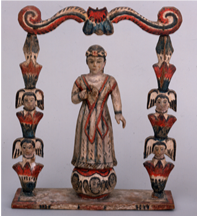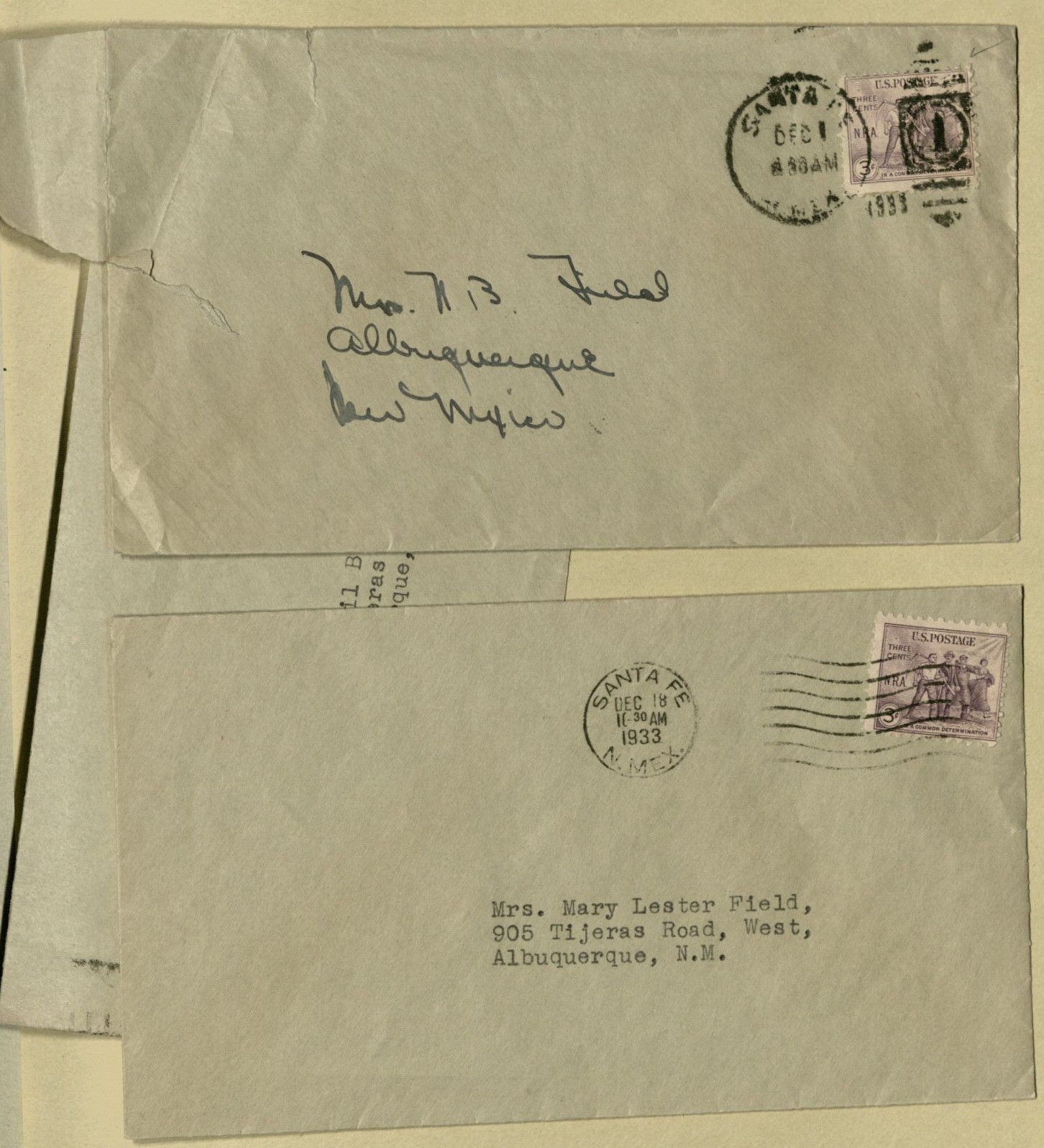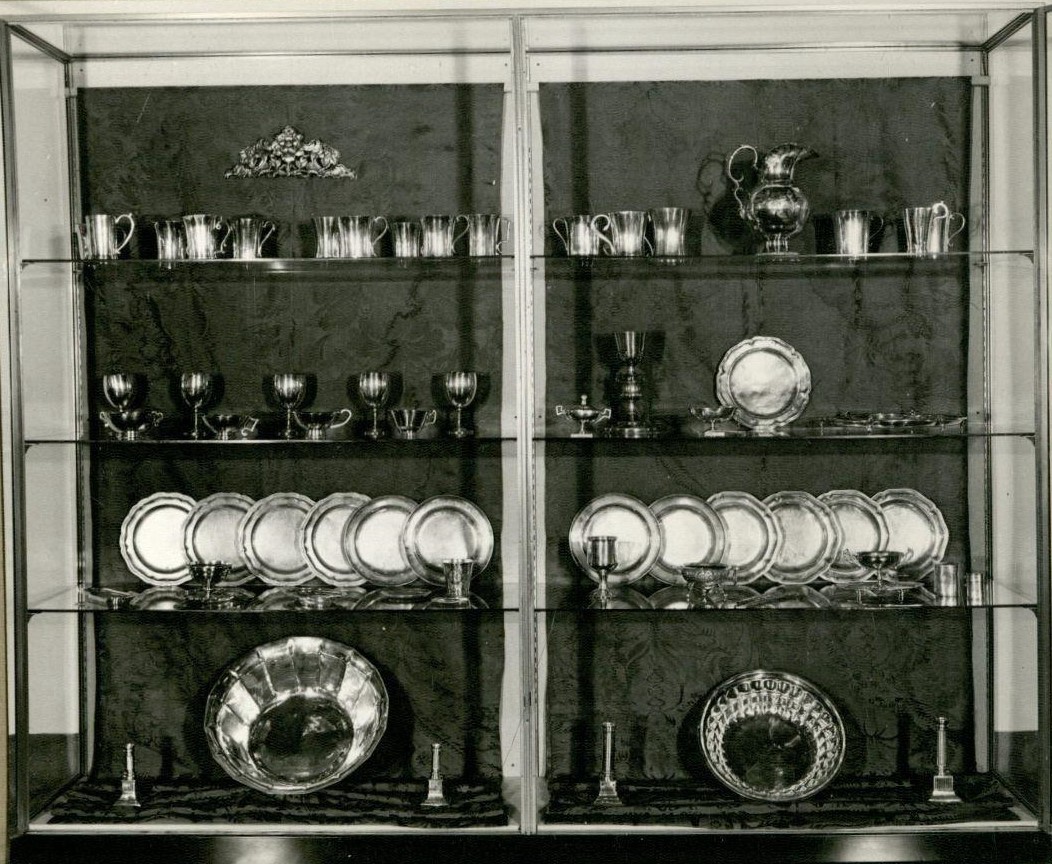Albuquerque’s Forgotten Collector: Mary Lester Field’s Spanish Colonial Collection
by David Saiz, MA Student in Art History and UNM Art Museum Research Assistant

In the Fall 2019 semester, Paloma Barraza (MA Student in Art History and UNM Art Museum Research Assistant) and I were asked to work with Spanish Colonial artworks in UNM Art Museum’s permanent collection. We were excited to have the opportunity to work directly in collection storage and see artworks that, in some cases, have not been publicly viewed since 1967. With this blog post, I would like to formally introduce the “Mary Lester Field and Neill B. Field Collection,” which is an important part of the UNM Art Museum’s permanent collection.
Mary Agnes Lester was born on October 2, 1862 in Pulaski, Tennessee, and likely traveled in the late 1880s from Denver to Albuquerque to visit her brother, Felix Hill Lester, an attorney “who had cast his lot with [a] small band of ‘Anglos’ who comprised a new American community in the broad valley of the Rio Grande.”[i] While in the territory of New Mexico, Mary Lester met and later married Kentucky-born lawyer, Neill Brooks Field (b. 1854, d. 1932), and the two became influential people in the area. He was the ninth mayor of Albuquerque and an elected representative for the Democratic National Committee — among other local political involvement.[ii] Unsurprisingly, Mary Lester Field’s death certificate indicates that her “trade or profession” was “housework” and her “place where she worked” was written in as, “our home.” It is unclear if Mary Lester Field had a public identity of her own, but “housework” was something she never needed to do as evidenced in a 1920 U.S. Census Bureau record indicating the couple had a cook, chauffeur, and maid/servant from the area.

Many of the works in this collection are attributed to the Northern province of New Spain with most of the pieces being acquired around the territory of New Mexico. Mary Lester Field’s collection of bultos(carved, three-dimensional religious icons) were a substantial addition to the university’s collection, with well-known artists such as Molleno (active c. 1815 — c. 1845), José Aragón (active 1820–1835), and José Manuel Benavides (active 1830–1855, now identified as the “Santo Niño Santero”) (fig. 2). Additionally, the focal point of the collection was the Spanish-colonial silver consisting of domestic objects, such as spoons, forks, trays, plates, cups, and candlesticks. The silver was repeatedly brought up in the New Mexico Lobo in the 1930s and 1940s. In 1932, shortly after the collection was willed to Zimmerman Library, the headline boasted, “University Receives Valuable Collection from Neill B. Field” and continues, “This collection, according to the New Mexico Tribune, is believed to be one of the finest in existence.”[iii] It is this overt absence of Mary Lester Field’s name that has drawn me to this collection and has motivated me to reconstitute her history.
It is important to establish that the collection was accumulated and cared for by Mary Lester Field. She was not only the wife of Neill B. Field, but rather an individual who wielded her own social and class-based power through her collection.[iv] She lived in a time when gender, “anchored women’s identity in their ability to manage their homes and raise their children. . . [while also identifying women] as the preservers, not creators, of culture.”[v] Lester Field, on the other hand, challenged these limitations through her collection, which functioned as a status marker for both her husband’s and her own position in the community. Additionally, this collection ensured Lester Field’s interests and local tastes were recognized and preserved. The above image shows the silver collection as it was displayed in the Field’s home, located at 905 West Tijeras Avenue in downtown Albuquerque, where the couple lived together for over four decades (fig. 1). With a home valued at $20,000 in 1930, the couple was one of the wealthiest families in the area. After Mr. Field’s death, Mary Lester Field lived out the rest of her live as the sole owner of the estate.[vi]Although the collection was willed to the University of New Mexico before Lester Field’s death on February 16, 1939, the collection did not physically move to Zimmerman Library until May 6th of the same year. Mr. Field’s 1932 will stated:
I feel much concern about the future of our collections of Old Spanish and Mexican silver, our collection of Spanish and Mexican shawls, and our collection of santos and bultos and other like articles as well as a ‘marriage scarf’ which is framed and hangs on the wall of the living room of our house. My dear wife has devoted a large part of the later years of her life to the assembling of these collections, and it is my belief that these and other articles in our home should become a part of a public museum where they may be available for the enjoyment and education of the people.[vii]
Mr. Fields recognized his wife’s commitment to collecting and the importance of the collection she created. He gives Mary Lester Field rightful credit, taking none for himself and pleading to the university to take the collection after he and his wife both passed away. Although it is unknown where the shawls and marriage scarf ended up, the silver collection became an asset for Mary Lester Field that other members of the New Mexico community were contending to acquire.
Later approached by the Society for the Revival of Spanish Colonial Arts, founded in 1929 by writer Mary Austin and artist Frank Applegate, Mary Lester Field was directly contacted by Austin. In 1933, Austin wrote a letter to Lester Field, whom Austin never met due to her failing health, expressing the society’s interest in acquiring the collection. In the letter Austin states, “I have heard of the collection of Native silver that you wish to leave to some group of people in the State as a rembrance [sic] of you and as a perpetual lagacy [sic].” Austin continues, following a three-page-long attempt to persuade Lester Field, “I hope I have said enough however to make you realize that this organization is the one to intrust [sic] your silver.”[viii] It is unknown whether or not Lester Fields responded to Austin, but her overbearing attempt to acquire the collection did not work. On December 16, 1933, Austin wrote back in a brief letter, “The mention of your collection of New Mexican antiques makes me regret more than ever that we could not have secured it for the Spanish Arts collection. I am sure we would have been able to give it more dignified publicity.” (figs. 2 and 3).[ix] The choice to keep the collection in Albuquerque was unexpected and significant since Santa Fe was the main hub for Spanish colonial art and collecting at this time. It is likely that Mary Lester Field’s desire to keep her collection in Albuquerque was due to her late husband’s connection to the university. Mr. Neill B. Field was one of a handful of local men who were responsible for creating the legislation to construct the University of New Mexico; therefore, Lester Field and her husband had very personal connections to Albuquerque and UNM.[x]


A total of 117 pieces were given to the Zimmerman Library (95 pieces of silver, 21 bultos, and one print by Gustave Baumann), under the “condition that it become the basis of a public museum to be maintained by the University.”[xi] The collection was displayed as it was in Lester Field’s home, “in the Otero Room on the north side of the second floor of the library [and] was for a time in the library browsing room” (figs. 4 and 5).[xii] The collection remained on view in the library up until it was transferred over into the care of the new University Art Gallery (today, UNM Art Museum) on October 10, 1963.[xiii]


Special thanks to the University of New Mexico Art Museum staff (Paloma Barraza, research assistant; Stephen Lockwood, museum collections manger; Devin Geraci, coordinator of events and visitor Services; Mariah Carrillo, marketing manager; Traci Quinn, curator of education and public programs; Mary Statzer, curator of prints and photographs; Arif Khan, director; Heather Kline, collections associate), the Albuquerque Main Library and the ABC Library Genealogy Center in downtown Albuquerque, New Mexico (Lisa Kindrick, librarian; Rosemary Winkler, librarian), the UNM Center for Southwest Research (Portia Vescio, University Archivist and staff), Nicólas Otero, Santero artist, and Lauren (Beth) Wilson-Norwood (Ph.D. Student in Art History) and Ellie Kane (Ph.D. Student in Art History).
[i] “Mary Lester Field was a southerner. She came from Tennessee to the little Spanish town of Albuquerque in 1866 … Here she fell in love with and married another transplanted southerner, Niel Brooks Field [sic].”After looking at census records, Mary Lester and her family were still in Tennessee in 1870. In 1880, the family had moved to Denver, Colorado. I am estimating that Mary Lester came to Albuquerque in the late 1880s based both on age and easier travel with the Atchison, Topeka, & Santa Fe Railroad reaching Santa Fe after 1880. See, Leona Mae Boylan, A Study of Mary Lester Field Collection of Spanish Colonial Silver, 5; U.S. Census Bureau, “Inhabitants in 13th Civil District, in the County of Williamson, state of Tennessee, enumerated by me on the 11 day of August, 1870; U.S. Census Bureau, “Inhabitants in Denver, in the County of Arapahoe, State of Colorado, enumerated by me on the Second day of June, 1880.
[ii] “Neill B. Field is a native of Louisville, Kentucky, where he was born, February 6, 1854. He received his education in the public schools of that city and at Forrest Academy, a celebrated preparatory course, he was offered and accepted employment in the office of the clerk of the Jefferson Circuit Court at Louisville, since which time he has been directly connected with the administration of justice in some capacity. He read law in the office and under the direction of Henry J. Stites, a nisi prius judge of great reputation, and was admitted to the bar before he arrived at his majority. Mr. Field came to New Mexico in 1882, settling at Socorro, where he practiced his profession in connection with Judge Albert Hagan, formerly of Salt Lake City. In 1884, he removed to Albuquerque [after a lynching scandal in Socorro of a man named Joe Fowler], where he has since practiced with great success, being recognized as the leader of the local bar and among the foremost lawyers of the Southwest. He was president of the New Mexico Bar Association in 1882. Mr. Field, although occupying a leading position in the councils of the democratic party, has never held any political elective office in New Mexico, except in 1893, when he was chosen mayor of the City of Albuquerque.” See, Ralph Emerson Twitchell, Esq., The Leading Facts of New Mexican History, vol. 2 (Albuquerque, New Mexico: Horn & Wallace Publishers, 1963): 601–02.
[iii] “University Receives Valuable Collection form Neill B. Field,” New Mexico Lobo 35, vol. 7 (1932): 1.
[iv]“As collectors, patrons, and museum founders, American women have played an influential role in national and international art circles from the late nineteenth century until today. With the rise of first-wave feminism [starting in the U.S. in 1848 after the Seneca Falls Convention], women acquired greater financial independence and access to education and professional careers. They also gained confidence in visiting galleries and museums and participating in cultural organizations. In turn, women commissioned and acquired fine art and decorative objects directly from the artists, or through dealers and commercial galleries. Some even went on to found museums in an effort to share their collections with broader audiences.” See, Patricia H. Svoboda, “American Women’s Role as Collectors, Patrons, and Museum Founders,” Smithsonian Collections Blog, Dec. 18, 2019
[v] Frances K. Pohl, Framing America: A Social History of American Art, Vol. 1(New York, N.Y.: Thames & Hudson, 2008): 265.
[vi] U.S. Census Bureau, “Department of Commerce — Bureau of the Census, Fifteenth Census of the United States: 1930, Population Schedule.”
[vii] Leona Mae Boylan, A Study of Mary Lester Field Collection of Spanish Colonial Silver (MA Thesis, University of New Mexico, 1967): 6.
[viii] Correspondence from Mary Austin to Mrs. Neill B. Field, 16 December 1933, MSS 31 BC, Box 1, Folder 6, Mary Hunter Austin Papers, Center for Southwest Research, University of New Mexico.
[ix] Ibid.
[x] William E. Davis, “Founding of the University of New Mexico, 1889–92,” In Miracle on the Mesa: A History of the University of New Mexico, 1889–2003(Albuquerque, New Mexico: The University of New Mexico Press for the Office of the President, 2006): 12.
[xi] “University Receives Valuable Collection form Neill B. Field,” New Mexico Lobo 35, vol. 7 (1932): 1.
[xii] “Silver at the Library,” The Summer Lobo 14, no. 1 (1948): 2.
[xiii] Clinton Adams, University Art Museum: The University of New Mexico Bulletin 1 (Winter 1965/66): 3.
